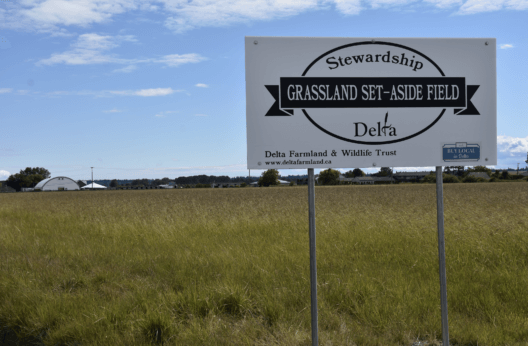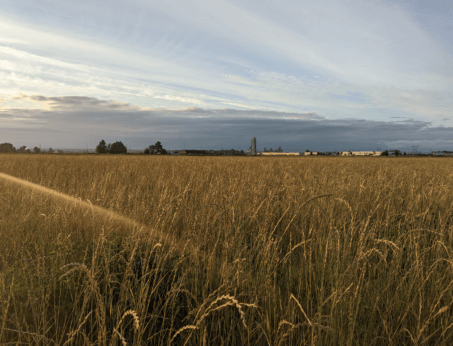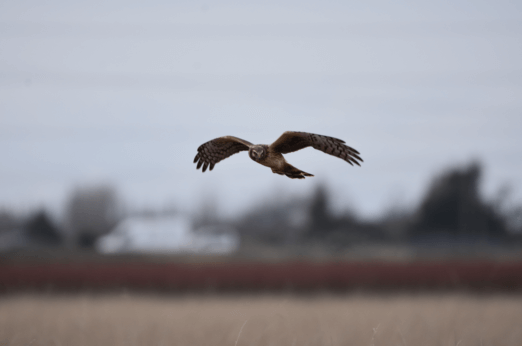When Not Farming is the Best Use of Land
Across North America, government agencies and groups promoting agricultural land conservation are asking growers and producers to remove land from active production and rewild it.
When Not Farming is the Best Use of Land
Across North America, government agencies and groups promoting agricultural land conservation are asking growers and producers to remove land from active production and rewild it.

by Delta Farmland & Wildlife Trust.
Asking a farmer to “uncrop” their land is a big ask. There’s a lot at stake, not the least of which are the economic losses unproductive land may cost the grower. Sometimes, though, it’s the best and only option for the land and its long-term productivity.
“Not all farmland is created equal,” says Jesse Womack, a conservation policy specialist with the National Sustainable Agriculture Coalition (NSAC). “Some acreages are inherently less productive than others.” The soil quality may not support crops or the land may not have appropriate water drainage. The cost of trying to create viable conditions for growing can be enormous and may not be worth the expense or the crop it might produce.
For many farmers, the answer is to enroll in the Conservation Reserve Program (CRP). Created by Congress in 1985, the CRP asks agricultural producers to voluntarily take environmentally sensitive land out of active production and conserve it. In return, they are paid a yearly rental rate per acre of land enrolled in CRP programs.
In 2023, he USDA Farm Service Agency made more than $1.77 billion in payments to agricultural producers and landowners enrolled in all CRP programs, and more than 23 million acres of private land in the US was being conserved.

Pros and Cons
Advocates of the CRP hail the program as protecting water quality, improving soil health and creating a refuge for wildlife and pollinators.
But not everyone agrees. The Environmental Working Group (EWG), a non-profit organization focused on public and environmental health, is advocating for a change to the CRP.
“Our biggest criticism of CRP,” says Anne Schechinger, mid-west director for EWG, “is that, as it is currently set up, it is not doing enough to store carbon in soil or reduce greenhouse gas emissions.” Agriculture is responsible for 10 percent of greenhouse gas emissions in the US. She also questions the long-term environmental benefits of the program if the reserved land is pressed back into service. All the carbon sequestered in the soil, she notes, gets released back into the atmosphere once the land is re-cropped.
“At least half of CRP acres go back into production after the end of the farmer’s contract, and most contracts only last for 10 years,” she says . “In general, permanently retiring farmland has much better benefits for the climate than even working lands with conservation.”
Short term versus long term
In southern British Columbia, the Delta Farmland & Wildlife Trust (DFWT) Grassland Set-Aside Stewardship Program (GLSA) also asks farmers to uncrop their fields and plant them with wildflowers, perennial grasses and broad-leafed plants. They’d argue that there are benefits even after a short period of uncropping (up to six years).
The GLSAs provide vegetative cover for foraging, roosting and nesting wildlife including raptors, wading birds, songbirds, pollinating insects and small mammals such as moles and mice. “We are ensuring farmland remains viable by balancing the needs of both the natural systems and the farmer,” says Christine Schmalz, executive director of DFWT. In this way, the program provides an opportunity to rejuvenate soil while supporting local wildlife.
A 2020-21 survey conducted by DFWT recorded greater use of the uncropped fields for habitat and hunting by raptors and the endangered Great Blue Pacific Heron, compared to cultivated fields. As the deep roots of the grasses and wildflowers permeate the soil, drainage is improved and the nitrogen levels in the soil increase, a key for building healthy root structures and plants. Research conducted by the Faculty of Land and Food Systems at the University of British Columbia further discovered that when GLSA fields are returned to agricultural use, the increased nitrogen levels lessen the need for fertilizers and the naturally enriched soil often produces increased crop yields compared to before the set-aside.
“One farmer noted to me recently that the potato crop is grown after a GLSA always has a substantial increase in yield for his fields,” says Schmalz.
But, despite these benefits, both Womack and Schmalz concede that farmers are finding it harder to take large areas of land out of productive use even for short periods. The annual rental rate paid to them often isn’t equal to what the farmer could make if they kept up production on the land.
In 2023, farmers enrolled with the DFWT were paid $500 (CDN) per acre. If that same land was producing a harvest of potatoes, a typical crop for the area, farmers could expect, based on 2020 prices, to have received approximately $736.56 (CDN) per metric ton from their harvests.
The Wetland Reserve Easement program administered by the USDA’s Natural Resources Conservation Service (NRCS) pays 100 percent of the easement value for the purchase of land and 75 to 100 percent of its restoration costs. This makes setting land aside lucrative and appealing.
“Way more farmers want to return land permanently into that program than there is funding for,” says Schechinger. “It is always overdrawn.”

Balance on the range
Farmland is not the only agricultural land that requires conservation. There are 770 million acres of rangeland in the United States. Areas of grasses, forbs, shrubs and dispersed trees are used for grazing cattle and other ruminants. CRP Grasslands works with producers to support grazing operations, plant and animal biodiversity. Conservation of this land requires a balanced approach.
The Society for Range Management (SRM) is a membership organization that provides educational resources for landowners, conservationists and producers. Julie Elliot is a director on SRM’s board. “Obviously, farming crops and rangelands are not compatible,” she says. “Removing livestock for even 10 years from this land can cause an ecological disaster in grassland communities.” Grassland foliage relies on the grazing and trampling of livestock to keep the soil aerated and the plant community growing. But when livestock graze on the same pasture repeatedly, plants don’t have the opportunity to recover and will die.
“It’s the combination of disturbance [grazing] and recovery that yields a healthy rangeland,” says Elliot.
In New York State, Stone Barns Center for Food & Agriculture strives to increase the production of the soil as well as ensure there is wildlife habitat, specifically for ground-nesting birds. By moving livestock daily, the land is not overgrazed and undisturbed areas for ground-nesting birds, such as the threatened Bobolink, have been established. This type of land management has also increased the water filtration capabilities of the soil.
“We had fields that two decades ago wouldn’t hold more than an inch of rain an hour; the rest would run off. Now, they absorb up to 16 inches of rain per hour,” says Jack Algiere, director of agroecology at Stone Barn. He credits this with the deep-rooted grasses aerating the soil and the added nutrients deposited from the manure of the grazing animals.
Initially, this type of land conservation can be expensive. Fencing, for example, may be needed to protect water systems from livestock. In the long run, though, costs are reduced. The need for fertilizer is lessened as the livestock service the soil through their manure. Herds are healthier, because of the biodiversity of the natural foliage they consume, which can reduce disease and veterinary costs.

Looking ahead
Incentives have been added to the draft of the upcoming Farm Bill that would allow farmers to enroll land into CRP programs for longer periods of time.
Congressman Jim Costa (D) from California has introduced the Conservation Reserve Program (CRP) Improvement Act of 2023. He is suggesting reforming the CRP to provide cost-share for the establishment of grazing infrastructure on all CRP practices and contracts, including interior cross fencing, perimeter fencing and water infrastructure.
Senators Chuck Grassley (R-Iowa) and Cory Booker (D-N.J.) have introduced the bi-partisan Conservation Reserve Program (CRP) Reform Act. They are proposing financial incentives for enrolling marginal land into CRP continuous categories, including providing the first five years of annual payments upfront and extending current contract lengths in the CRP Continuous and Grassland programs to 30 years.
Back in Canada, a raptor is hunting over a set-aside field. It’s a sign of success for the DFWT. “We are ensuring farmland remains viable by balancing the needs of both the natural systems and the farmer,” says Schmalz.
Follow us

This work is licensed under a Creative Commons Attribution-NoDerivatives 4.0 International License.
Want to republish a Modern Farmer story?
We are happy for Modern Farmer stories to be shared, and encourage you to republish our articles for your audience. When doing so, we ask that you follow these guidelines:
Please credit us and our writers
For the author byline, please use “Author Name, Modern Farmer.” At the top of our stories, if on the web, please include this text and link: “This story was originally published by Modern Farmer.”
Please make sure to include a link back to either our home page or the article URL.
At the bottom of the story, please include the following text:
“Modern Farmer is a nonprofit initiative dedicated to raising awareness and catalyzing action at the intersection of food, agriculture, and society. Read more at <link>Modern Farmer</link>.”
Use our widget
We’d like to be able to track our stories, so we ask that if you republish our content, you do so using our widget (located on the left hand side of the article). The HTML code has a built-in tracker that tells us the data and domain where the story was published, as well as view counts.
Check the image requirements
It’s your responsibility to confirm you're licensed to republish images in our articles. Some images, such as those from commercial providers, don't allow their images to be republished without permission or payment. Copyright terms are generally listed in the image caption and attribution. You are welcome to omit our images or substitute with your own. Charts and interactive graphics follow the same rules.
Don’t change too much. Or, ask us first.
Articles must be republished in their entirety. It’s okay to change references to time (“today” to “yesterday”) or location (“Iowa City, IA” to “here”). But please keep everything else the same.
If you feel strongly that a more material edit needs to be made, get in touch with us at [email protected]. We’re happy to discuss it with the original author, but we must have prior approval for changes before publication.
Special cases
Extracts. You may run the first few lines or paragraphs of the article and then say: “Read the full article at Modern Farmer” with a link back to the original article.
Quotes. You may quote authors provided you include a link back to the article URL.
Translations. These require writer approval. To inquire about translation of a Modern Farmer article, contact us at [email protected]
Signed consent / copyright release forms. These are not required, provided you are following these guidelines.
Print. Articles can be republished in print under these same rules, with the exception that you do not need to include the links.
Tag us
When sharing the story on social media, please tag us using the following: - Twitter (@ModFarm) - Facebook (@ModernFarmerMedia) - Instagram (@modfarm)
Use our content respectfully
Modern Farmer is a nonprofit and as such we share our content for free and in good faith in order to reach new audiences. Respectfully,
No selling ads against our stories. It’s okay to put our stories on pages with ads.
Don’t republish our material wholesale, or automatically; you need to select stories to be republished individually.
You have no rights to sell, license, syndicate, or otherwise represent yourself as the authorized owner of our material to any third parties. This means that you cannot actively publish or submit our work for syndication to third party platforms or apps like Apple News or Google News. We understand that publishers cannot fully control when certain third parties automatically summarize or crawl content from publishers’ own sites.
Keep in touch
We want to hear from you if you love Modern Farmer content, have a collaboration idea, or anything else to share. As a nonprofit outlet, we work in service of our community and are always open to comments, feedback, and ideas. Contact us at [email protected].by Jennifer Cole, Modern Farmer
January 19, 2024
Modern Farmer Weekly
Solutions Hub
Innovations, ideas and inspiration. Actionable solutions for a resilient food system.
ExploreExplore other topics
Share With Us
We want to hear from Modern Farmer readers who have thoughtful commentary, actionable solutions, or helpful ideas to share.
SubmitNecessary cookies are absolutely essential for the website to function properly. This category only includes cookies that ensures basic functionalities and security features of the website. These cookies do not store any personal information.
Any cookies that may not be particularly necessary for the website to function and are used specifically to collect user personal data via analytics, ads, other embedded contents are termed as non-necessary cookies.
It’s impossible to compare the $500 per acre the CRP pays with the $736 per ton for growing potatoes without knowing how many tons are harvested per acre and how much of that is profit. Other than that, the article was very informative.